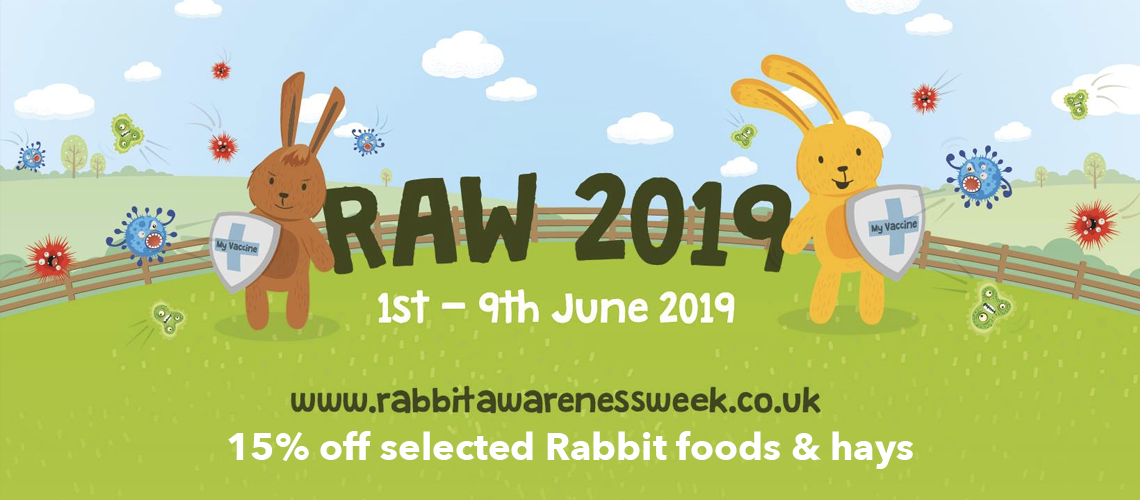
Last year the RAW theme was 'Move Away From Muesli' and highlighted the importance of feeding rabbits a healthy diet of good-quality feeding hay and a small portion of nuggets rather than muesli.
Research has shown that muesli-based diets encourage selective feeding, where rabbits eat some components of the muesli diet while rejecting the more fibrous pellets. Selective feeding in this way increases the risk of:
• Dental Disease
• Obesity
• Digestive Problems
Despite this, according to the PDSA PAW Report 2017, 25% of rabbit owners in the UK still feed their rabbits muesli.
This Year the RAW theme is ‘Protect & Prevent’ with the aim to raise awareness around Rabbit Viral Haemorrhagic Disease 2 (RVHD2). RVHD2 is a new variant of RVHD1 and is often fatal.
Many rabbits in the UK are not vaccinated against this deadly disease and are therefore at risk. This year we are asking all rabbit owners in the UK to make sure that their rabbits are vaccinated against this and other fatal diseases.
RVHD2
About RVHD2
Rabbit Viral Haemorrhagic Disease 2 (RVHD2) is a new strain of the virus RVHD1. Cases of the disease were first reported in the UK in 2015. As with RVHD1 the virus causes internal bleeding.
Symptoms
RVHD2 often has no symptoms, meaning that it is very hard to spot early on. Where symptoms do occur these signs are easily confused with other health conditions: fever, lethargy, neurological signs (coma) and blood clotting problems.
Mode of transmission
It is a myth that RVHD2 can only be caught through contact with an infected rabbit. In actual fact the virus can be carried by:
Birds and insects and their droppings
The wind
Soles of shoes, car tyres or other pets’ feet
An infected rabbit or their droppings
Owners’ hands or clothes
This is just a small section of the list of ways RVHD2 can be carried. Practically, there is no way to stop the virus getting into your rabbits’ indoor or outdoor environment. Therefore, the only way to protect your rabbits is through vaccination.
Prevention
Your vet can vaccinate your rabbits against RVHD2 (this is a separate vaccination to the combined myxomatosis/RVHD1 vaccine). Your vet will then advise what booster vaccinations your rabbit will need (usually every 6-12 months).
Treatment
There is no specific treatment available for RVHD2, though your vet can offer supportive care.
Prognosis
There have been some cases where rabbits have recovered from RVHD2. However, in most cases the disease is fatal.
RVHD1
About RVHD1
Rabbit Viral Haemorrhagic Disease 1 (RVHD1) is an extremely infectious virus that is usually fatal. RVHD1 the virus kills by causing internal bleeding.
Symptoms
RVHD1 often has no symptoms, meaning that it is very hard to spot. There is sometimes bleeding from body openings such as the nose, eyes and/or anus, but these are very easy to miss without daily checks.
Mode of transmission
It is a myth that RVHD1 can only be caught through contact with an infected rabbit. In actual fact the virus can be carried by:
Birds and insects and their droppings
The wind
Soles of shoes, car tyres or other pets’ feet
An infected rabbit or their droppings
Owners’ hands or clothes
The virus can survive months in the environment, especially in cold temperatures.
Prevention
Your vet can vaccinate your rabbits against RVHD1 (this is often done with the Nobivac combined vaccination for myxomatosis and RVHD1). Your vet will then advise what booster vaccinations your rabbit will need (usually every 12 months).
Treatment
There is no specific treatment available for RVHD1, though your vet can offer supportive care.
Prognosis
RVHD1 is usually fatal within a couple of days to weeks. There are very limited examples of rabbits surviving the disease.
Myxomatosis
About Myxomatosis
Myxomatosis has been present in the UK since it was introduced from South America in the 1950s. It killed a very high percentage of the wild rabbits, and still kills many wild and pet rabbits every year.
Symptoms
The full-blown form of myxomatosis affects the eyelids, the skin of the ears, lips and genitals causing swellings.
There is a purely skin form of myxomatosis, which isn’t usually fatal, it causes small thickened lumps of skin to form on the eyelids, nose, head and sometimes the shoulders. These typically fall away after 2-3 weeks.
Mode of transmission
Myxomatosis is mainly spread by direct contact by fleas. Rabbits fleas are the most common carriers but flying and biting insects can spread it. Rabbits can also catch the disease through direct contact with other rabbits.
Prevention
Your vet can vaccinate your rabbits against myxomatosis (this is often done with the Nobivac combined vaccination for myxomatosis and RVHD1). Your vet will then advise what booster vaccinations your rabbit will need (usually every 6-12 months). Vaccination can take place from five weeks of age and take three weeks to become effective.
Vaccination is very effective; however, vaccinated rabbits can still get a milder form of the disease. The prognosis for vaccinated rabbits is very good with the majority fully recovering.
Treatment
There is no specific treatment available for myxomatosis, though your vet can offer supportive care.
Prognosis
The prognosis for an unvaccinated rabbit with full-blown myxomatosis is usually a long and painful death. Therefore, euthanasia is preferable.
The prognosis for a rabbits with just the skin form or a rabbits that are vaccinated is usually good with the majority surviving without needing significant treatment.
Find our more - www.rabbitawarenessweek.co.uk/





Leave a comment (all fields required)